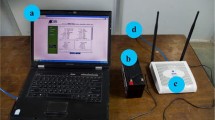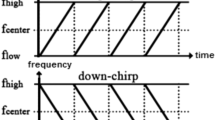Abstract
Field measurements of signal strength is one of the basic techniques for coverage determination of a cellular network. In this paper, we report on the experimental study of the signal strength measurements in a typical worldwide interoperability for microwave access network operating at 2.62 GHz installed for fixed wireless access in the district of Greater Noida, Uttar Pradesh, India. The experimental data are analyzed for deriving characteristic parameters of the radio propagation environment. The characteristic parameters include path loss exponent and standard deviation of shadow fading. Having derived the characteristic parameters, we propose path loss models for the cellular network. The study also aims at the determination of network coverage for the given system parameters. Results and their analysis are utilized for network planning and optimization of the system parameters for the installed cellular network.





Similar content being viewed by others
References
Alqudah, Y. A. (2012). Path loss modelling based on field measurements using deployed 3.5 GHz WiMAX network. Wireless Personel Communication. doi:10.1007/s11277-012-0612-8.
Dalela, C., Prasad, M. V. S. N., & Dalela, P. K. (2012). Some experimental investigation in the WiMAX band and comparison of propagation models in mixed urban environments of Western India. Annals of Telecommunication. doi:1007/S12243-012-0298-7.
Sapumohotti, C., Alias, M. Y., Ching, H. C., & Kwee, W. K. (2011). Low cost network planning tool development using Google Maps, SRTM Data and MATLAB. 978-1-61284-663-7/ \(\copyright \) 2011 IEEE.
Alshami, M., Arslan, T., Thompson, J., & Erdogan, A. (2011). Evalution of path loss models at WiMAX cell-edge. 978-1-4244-8704-2/11 \(\copyright \) 2011 IEEE.
Li, K., Jiang, P., & Bigham, J. (2011). Partitioning the wireless environment for determining radio coverage and traffic distribution with user feedback. 978-1-61284-091-8/11.2011 IEEE.
Sgora, A., Gizelis, C. A., & Vergados, D. D. (2010). Network selection in a WiMAX–WiFi environment. 1574-1192/s Elsevier @ 2010.10.001.
Prasad, M. V. S. N., Ratnamala, K., & Dalela, P. K. (2010). Mobile communication measurements along railroads and model evolutions over Eastern-Indian rural regions. IEEE Antennas and Propagation Magazine, 52(5), 131–141.
Janevski, T., & Nikolic, V. (2010). Radio optimization of high speed mobile networks. IEEE 978-0-7695-4021-4/10 2010.
Galvan-Tejada, G. M. (2010). WIMAX urban coverage based on the Lee model and the Deygout diffraction method. 978-1-4244-7314-4/10 \(\copyright \) 2010 IEEE.
Pontes, M. S., & Silva Mello, L. A. R. (2010). Review on terrestrial propagation channel modeling. IEEE Antennas and Propagation Magazine, 52(5).
Rashed, M. M. G., Joni, S. U. M., & Siddique, Md. M. I., (2010). Radio network planning for fixed WiMAX in Dhaka City and it’s performance, analysis. 978-1-4244-8494-2/10 \(\copyright \) 2010.
Abou-Jaoude, R., Ulhaq, N., Hartmann, C. (2009). HSDPA throughput optimization with antenna tilt and pilot power in a moving hot-spot scenario. IEEE 978-1-4244-2515-0/09 2009.
Drieberg, M., Zheng, F.-C., Ahmad, R., & Fitch, M. (2009). Impact of interference on throughput in dense WLANs with multiple APs. IEEE 978-1-4244-5213-4/09 2009.
Hosein, P. (2009). System capacity of a two-sector OFDMA downlink with QoS constraints. IEEE 978-1-4244-5213-4/09 2009.
Fan, P. (2009). Research of wireless network planning based on WiMAX. 978-0-7695-3901-0/09 \(\copyright \) 2009.
Singh, B. J., Aggarwal, K. K., & Kumar, S. (2007). Characterization of the propagation environment by field measurements. Institution of Engineers(India), Electronics and Telecom Division, 88, 22–25.
Theodoros, T., & Kostantinos, V. (2007). WiMAX network planning and system’s performanance evalution. 1525-3511/07 \(\copyright \) 2007.
Marques, M., Ambrosio, J., Reis, C., Guveia, D., Riscado, J., Robalo, D., et al. (2007). Design and planning of IEEE 802.16 network. 1-4244-1144-0/07 \(\copyright \) 2007 IEEE.
Prasad, M. V. S. N., Dalela, P. K., & Singh, R. (2005). A comparison of land mobile radio prediction methods in Indian rural zones. 7803-8964-6/05 2005 IEEE.
Abhayawardhana, V. S., Wassell, I. J., Crosby, D., Sellars, M. P., & Brown, M. G. (2005). Comparison of empirical propagation path loss models for fixed wireless access systems. In IEEE vehicular technology conference (VTC ’05) (Vol. 1, pp. 73–77).
Prasad, M. V. S. N., & Singh, R. (2003). Terrestrial mobile communication train measurements in Western India. IEEE Transactions on Vehicular Technology, 52, 671–681.
Zhao, X., & Vainkainen, P. (2001). Multipath propagation study combining terrain diffraction and reflection. IEEE Transactions on Antenna Propagation, 49(8), 1204–1209.
Prasad, M. V. S. N., & Singh, R. (2000). UHF train radio measurements in northern India. IEEE Transactions on Vehicular Technology, 49, 239–245.
Xia, H., & Bertoni, H. L. (1992). Radio propagation measurements and modeling for line of sight microcellular systems. In IEEE vehicular technology conference, p. 349.
Rappaport, T. S. (2007). Wireless communications (2nd ed.). New Delhi: PHI.
Mishra, A. R. (2004). Fundamentals of cellular network planning and optimization (2G–4G). UK: Wiley.
Author information
Authors and Affiliations
Corresponding author
Rights and permissions
About this article
Cite this article
Sharma, S., Singh, B. Experimental Study of a Fixed WiMAX Network at 2.62 GHz. Wireless Pers Commun 72, 2127–2141 (2013). https://doi.org/10.1007/s11277-013-1139-3
Published:
Issue Date:
DOI: https://doi.org/10.1007/s11277-013-1139-3




